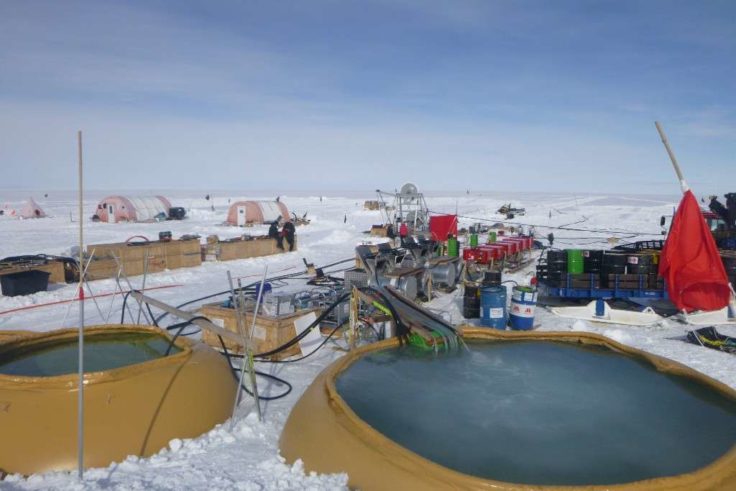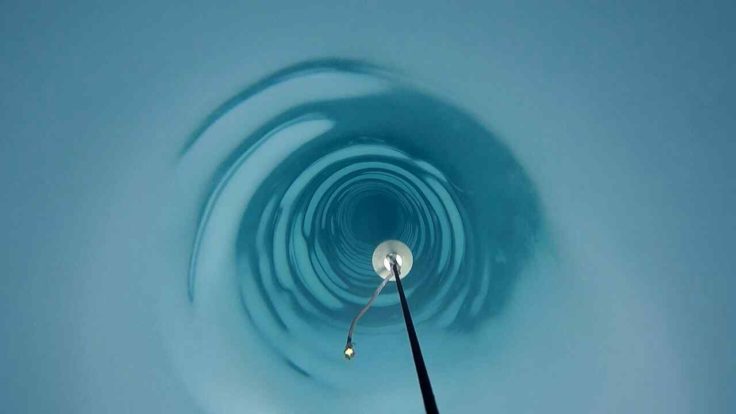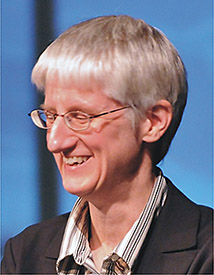Drilling for success
29 January, 2019 by Michael Dinn
In January 2019 a science and engineering team drilled over two kilometres through the ice sheet in West Antarctica using hot water. It was the first time they had done this …
The polar ice sheets play a major role in controlling Earth’s sea level and climate, but our understanding of their history and motion is poor. The biggest uncertainty in predicting future sea level comes from the Antarctic and the Greenland ice sheets. Reducing this uncertainty is one of the biggest challenges in glaciology.
Improving our understanding is essential because:
The Antarctic and Greenland ice sheets play a major role in controlling Earth’s sea level and climate, but our understanding of their history and motion is poor.
At the moment, the biggest uncertainty in our ability to predict future sea level comes from these ice sheets. This is particularly important because sea level rise from ice sheets is increasing faster than expected, and because ice sheets have the potential to trigger irreversible sea level rise that would continue for many centuries.
BEAMISH tackles two aspects of uncertainty; first, the past behaviour of the West Antarctic Ice Sheet, and second, the flow of the fast “ice streams” that drain it.
Through measurements at the ice surface, and by drilling to the bed of Rutford Ice Stream, we will find how long ago the ice sheet last disappeared completely, and how water and soft sediments underneath it helped the ice move fast on its journey to eventually melting in the sea.
The ice of Rutford Ice Stream is well over 2 km thick and drilling right through it is a huge challenge. We will use a large hot-water drill which will take up to 2 days to melt down to the bed. The largest parts of the drill weigh up to 7 tonnes. It took 3 years to put equipment and fuel in place ready for the fieldwork.

When the drill reaches the bed sections of ice core from the ice column and samples of sediment from beneath the ice are collected.
Strings of instruments lowered down the holes measure the pressure in the water system beneath the ice, the temperature profile in the ice and the way the ice deforms as it flows downstream. Probes inserted into the bed measure how fast the ice is sliding, as well as the strength of the sediment in the bed itself.
Borehole video cameras will record the nature of the ice, bed and water system, including how much sediment is frozen into the bottom of the ice. On the ice stream surface we will carry out a number of geophysical experiments designed to study the flow of the ice and to map the topography and the variations in basal water and sediment in the area around the drill holes. This will help us to interpret the measurements made in the drill holes.

GPS receivers will track the motion of the ice surface; seismic surveys will map the softer and harder areas of bed sediment; radar surveys will show where water beneath the glacier is concentrated or distributed; and a seismometer array will detect the noise bursts emitted as the ice stream grinds over its bed.
Project results will be analysed at British Antarctic Survey, Swansea University and NERC-GEF. Other project partners at NASA-JPL, University College London and the University of Bristol will also contribute.
Rutford Ice Stream is one of the large, fast-flowing glaciers that drain WAIS and deliver the ice to the ocean. It has the advantage that a large amount of data have already been collected there from surface fieldwork, from aircraft, and from satellites. The existing data helps identify the optimum locations for this. In 2018-19 we will access the ice stream bed directly.
Understanding the timing of the last ice sheet collapse is extremely valuable because no other information yet exists in this region. This knowledge will help us to understand the way the ice sheet has changed as climate has warmed and cooled in the past.
Our other results – characterising ice stream dynamics and how ice, water and the sedimentary bed interact – will help us understand the processes by which ice streams move, and how we should include these processes into models. The results will help to clarify previous work from ice streams elsewhere in Antarctica, which in some cases have been contradictory or inconclusive.
Overall, these results will be big steps forward in our ability to understand the way ice sheets behaved in the past, what controls them today, and how they might evolve in the future.
BEAMISH’s aims are both academic and practical. The overall goal is to find out how Rutford Ice Stream has changed in the past and is flowing today. To do this we will:
Our project aims to improve our understanding of two aspects of this uncertainty: first, the past behaviour of the West Antarctic Ice Sheet (WAIS), and second, the flow of the fast ice streams that drain it. By choosing the right location, we can address both these aims within one project.
When completed, the project will give information on:
Interim Director of Science
BAS Science Strategy Executive Group, BAS Management team, Palaeo Environments, Ice Sheets and Climate Change team
Project partners include the universities of Swansea, Bristol, UCL and Leeds, and with Pennsylvania State University and the US National Science Foundation.
BAS Polar Oceans: Tom Stroud

Prof. Tavi Murray, University of Swansea

Prof. Jemma Wadham, University of Bristol

Prof Peter Sammonds UCL

Prof. Bryn Hubbard, University of Aberystwyth
29 January, 2019 by Michael Dinn
In January 2019 a science and engineering team drilled over two kilometres through the ice sheet in West Antarctica using hot water. It was the first time they had done this …
4 May, 2020
As the world continues to work around lockdown, the EGU General Assembly 2020 will take place this week (4-8 May) online. The annual EGU (European Geosciences Union) meeting, which usually …
24 January, 2019
A team of scientists and engineers has for the first time successfully drilled over two kilometres through the ice sheet in West Antarctica using hot water. This research will help …
29 November, 2016
As spring returns to the southern hemisphere British Antarctic Survey (BAS) has started another research season which will take them over land, sea and ice in search of answers to …
23 November, 2015
New season tackles ambitious science and logistical challenges The British Antarctic Survey (BAS) 2015/16 field season is underway with dozens of scientists and support staff – together with planes and tonnes …
19 November, 2015
Sea-level rise from Antarctic collapse may be slower than suggested A new study by scientists in the UK and France has found that Antarctic ice sheet collapse will have serious …